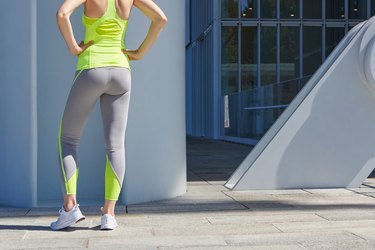
While big and strong muscles can be aesthetically pleasing, they're also responsible for moving your body, keeping you active. Without strong muscles, you're more prone to injury, which could develop into chronic pain or muscle fatigue.
Being the biggest muscle in the body, your glutes are responsible for a lot of the movements we complete each day. But your lats and quads are key players in everyday motion, too. Learn where these muscles are located, what they do and how you can keep them strong and healthy.
Video of the Day
Video of the Day
Different Types of Muscle: Cardiac, Smooth and Skeletal
Your body is made up of three types of muscle: cardiac, smooth and skeletal, according to The Library of Congress. Cardiac and smooth muscles help protect the internal organs of your body. While cardiac muscle protects the heart and keeps it pumping, smooth muscle makes up the walls of your intestines, uterus and blood vessels.
Skeletal muscles are attached to the bones and contract to make your limbs and body parts move, according to The Library of Congress. In other words, the skeletal muscles are the ones you can see and strengthen. While your body has more than 650 skeletal muscles, certain ones are larger and stronger than others.
1. Gluteus Maximus
What's the biggest muscle in the body? You may be sitting on it right now. The gluteus maximus is the biggest muscle in the human body, according to The Library of Congress. More commonly known as the glutes, this muscle is located behind your hips and is responsible for things like keeping your body upright and helping you walk up stairs. Basically, your glutes are responsible for most all movement of the lower body.
Your glutes are comprised of three parts: the gluteus maximus, the gluteus medius and the gluteus minimus. Your gluteus maximus is a major extensor of the hip and is responsible for helping rotate your thigh, according to the University of Washington Department of Radiology. Your gluteus medius helps rotate your hip laterally, while the gluteus minimus helps adduct the hip.
Although the glutes are the largest muscle in the human body, they're often one of the most neglected in the weight room, according to the National Academy of Sports Medicine (NASM). Strengthening your glutes can help improve your posture and ability to complete everyday activities like climbing stairs (especially later in life). It can also help prevent and lessen lower back pain, according to a 2015 study published in the Journal of Physical Therapy Science.
NASM recommends that you introduce glute-focused exercises like squats, side steps, hip thrusts and lunges into your weekly strength routine. As you perform these exercises, think about consciously squeezing the muscle in every repetition, to ensure you're really activating it.
2. Latissimus Dorsi
The largest muscle in your upper body, the lattismus dorsi (more commonly known as the lats) is a broad muscle located across the lower part of the back, according to Exercise Prescription. Your lats help move your core and arms and work with the teres major (a muscle in your outer back) to help move your upper body.
Exercising and strengthening your lats is extremely important in developing thoracic mobility (or, fluid movement of the 12 vertebrae in the mid-back), according to NASM. Those that lack mobility in their thoracic spine are more prone to injury in the shoulders and neck and may also experience lower back pain.
When your lats are short and tight, they affect the motion of your thoracic spine. So, NASM recommends that you incorporate foam rolling to loosen the muscle. With a foam roller, roll the lateral edge of your shoulder blade from bottom to top, pausing on tender points for about 30 seconds.
3. Quadriceps
Your quadriceps — also known as your quads — are another large muscle group located on the front of your thighs. They're responsible for helping extend your knees and bend your hips, according to Exercise Prescription, and made up of four different muscle heads: The rectus femoris, vastus lateralis, vastus intermedius and vastus medialis.
Your quads are key for general everyday movement, like walking, running, squatting, cycling and keeping balance. This means that a muscle strain —which commonly occurs when you overstretch or pull your quad — could leave you out of commission for a while.
Regularly exercising and stretching these muscles can help protect from injury. Incorporating movements like squats, deadlifts and lunges is a great place to start, according to the American Council on Exercise. But don't forget a proper cool down and stretch — like a side lying quad stretch — post workout.
- University of Washington: Muscle Atlas
- The Library of Congress:" What is the strongest muscle in the human body?"
- University of Washington Department of Radiology: "Gluteus Maximus"
- University of Washington Department of Radiology: "Gluteus Medius"
- University of Washington Department of Radiology: "Gluteus Minimus"
- National Academy of Sports Medicine: "7 WAYS TO EFFECTIVELY BUILD STRONGER, LARGER GLUTES!"
- NASM: "HOW TO IMPROVE THORACIC MOBILITY"
- Exercise Prescription: "Quadriceps"
- Alberta Health Services: "Quadriceps Strain: Care Instructions"
- AMerican Council on Exercise: "Upper Leg Exercises"
- Exercise Prescription: "Latissimus Dorsi"
Is this an emergency? If you are experiencing serious medical symptoms, please see the National Library of Medicine’s list of signs you need emergency medical attention or call 911.